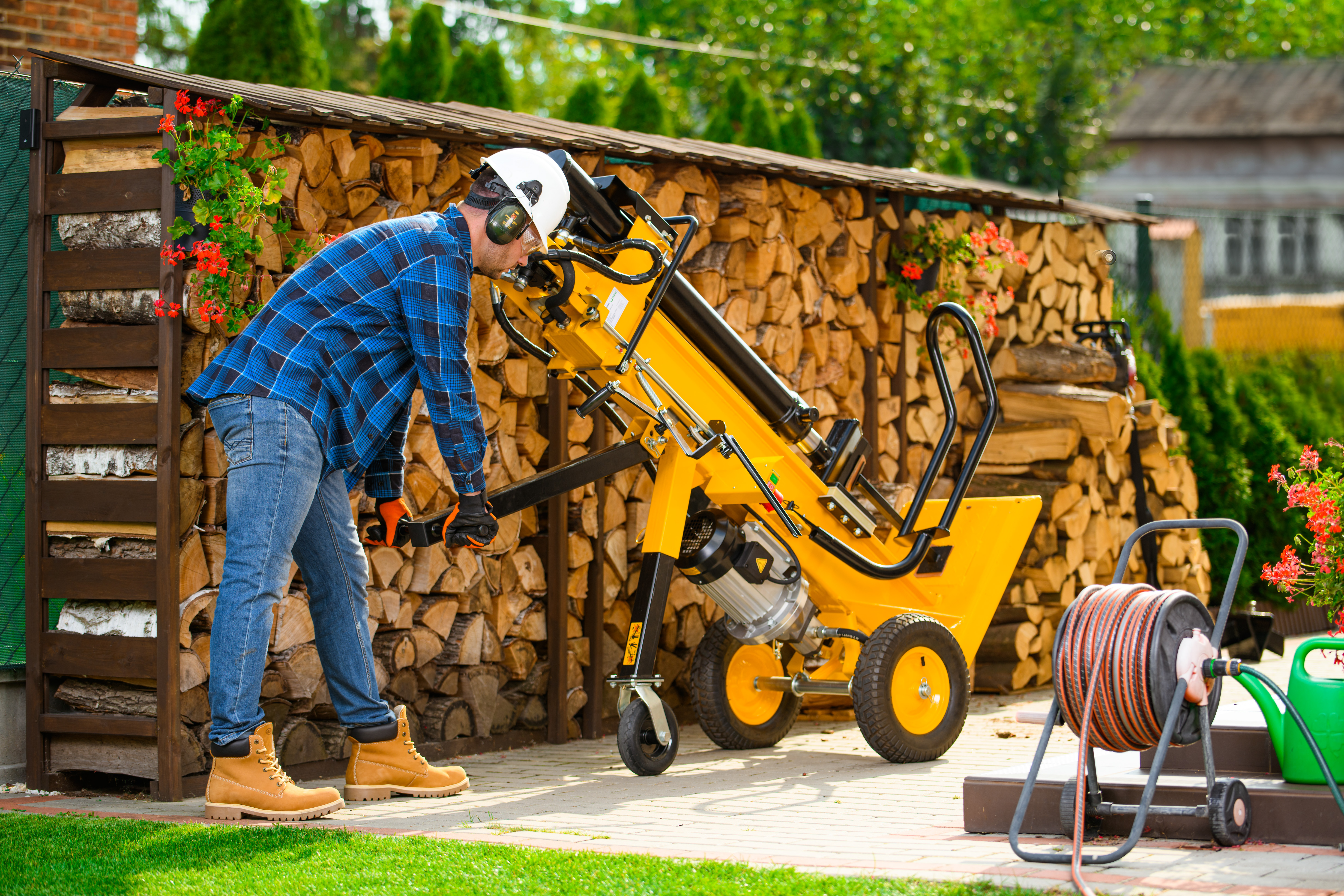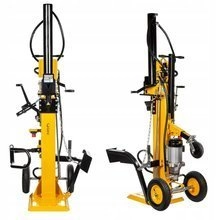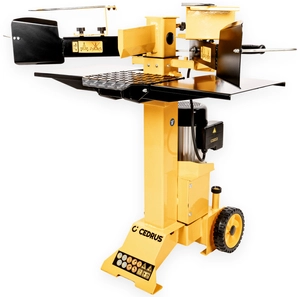Wood splitters - answers to the most common customer questions

Which device will work best for splitting wood?" or "Does the use of splitters involve any risks?" - these types of questions we often hear from our interested customers. In today's article we will try to shed some light on the subject of wood splitters. We have collected the most vexing issues that regularly arise in conversations with our customers and decided to provide comprehensive answers to them. We will discuss the different types of splitters, their advantages, safety aspects and proper methods of using them. If you are considering buying a splitter or want to find out which model will best meet your needs, this article is sure to interest you.
What is the best hydraulic oil for a splitting machine?
Choosing the right hydraulic oil is critical to the smooth operation of the splitter. Among professionals and experienced users, HL46 oil enjoys special recognition. Its popularity is due to its optimum viscosity and density, which are ideal for hydraulic systems subjected to high mechanical loads. Nevertheless, it is always a good idea to consult the instruction manual for a particular model of splitter - manufacturers often have their specific recommendations, which may vary depending on the design of the device.
How to choose the right actuator for a splitting machine?
The actuator is the heart of the splitter, responsible for generating the force needed to split wood efficiently. Its selection should take into account several key factors: the type of wood you most often work with, the design of the splitter and its type of. An interesting observation, often emphasized by our customers, is the relationship between the diameter of the actuator and its power - the larger the diameter, the greater the splitting power. However, it is worth remembering that the biggest does not always mean the best - the key is to find the optimal solution for your specific needs.
How to properly change the oil in a wood splitter?
The process of changing the oil in a wood splitter, while it may seem complicated, is crucial to keeping the machine in good shape. Here is a step-by-step guide on how to carry out this procedure:Start by locating and unscrewing the oil drain plug.Prepare a suitable container to collect used oil.When draining the oil, pay attention to its consistency and color. The presence of metallic shavings can signal mechanical problems.After completely draining the system, carefully screw the drain plug on.Then, through the filler hole, refill the system with fresh hydraulic oil recommended by the manufacturer.After changing the oil, run the splitter several times without a load so that the new oil is evenly distributed in the system.Finally, check the oil level with the rod indicator, making sure it is optimal.Changing the oil regularly according to these steps will significantly extend the life of your splitter and ensure its effective operation for a long time.
How to effectively vent a wood splitter?
The process of venting a wood splitter is crucial to its effective operation. It usually involves carefully unscrewing the filler cap or vent screw before starting the unit. The goal is to allow air to gently escape from the oil tank. However, it is worth remembering that the exact procedure may vary depending on the design of the splitter and the location of the drain plug. It is always a good idea to read the instruction manual for a particular model to carry out the process correctly and safely.
What are the log size capabilities of the splitter?
The ability of a splitter to split logs of a certain diameter and width depends on several key factors:Power of the actuator - the higher the power, the thicker the logs can be split.Space between the stops - determines the maximum width of the log.Type and hardness of wood - for example, beech requires more power than softer species.Manufacturers typically provide specifications for maximum log sizes for each model. However, it is worth remembering that these values may vary in practice, depending on the factors mentioned above.
What engine power is optimal for a wood splitter?
Selecting the right engine power for the splitter is the result of precise engineering calculations. The motor power must be perfectly matched to the piston and hydraulic cylinder used. In the case of electric splitters, the most common are motors with a power of 3 to 7.5 kW. Diesel splitters, on the other hand, are usually equipped with more powerful units, with power ranging between 5 and 15 kW. Choosing the right power depends on the planned application and the intensity of the splitter's work.
What is the maximum length of the billet that the splitting chamber can accommodate?
The capacity of the splitting chamber may vary considerably depending on the model and purpose of the splitter. Splitters designed for home use are usually able to handle pieces of wood up to 55 cm long. Industrial models, on the other hand, designed for more intensive work, can accept billets up to 110 cm long. When choosing a splitter, it is worth considering the typical length of the billets you will be working with to ensure optimum performance and convenience of use.
Is it worth it to choose a 230V or power splitter?
Choosing between a 230V and 400V (so-called "by force") splitter is a common dilemma among our customers. If you have easy access to a three-phase outlet, we recommend choosing a 400V splitter. For equipment up to 10 tons, 230V splitters are just as effective and you won't notice a difference in operation or operating costs.However, at higher power, 400V splitters become a better choice due to their higher efficiency.
Do standard splitters have a wedge that divides the wood into 4 parts?
As standard, most wood splitters are equipped with a simple wedge that divides the log into two parts. Some manufacturers offer the possibility to buy a cross wedge as an additional option. Such a wedge makes it possible to split wood into 4 parts, which can significantly increase the efficiency of work.
What type of wedge is best for splitting wood?
Choosing a cross wedge, dividing the wood into 4 parts, can greatly speed up the splitting process. If the manufacturer offers this option, it is worth considering. The cross wedge is particularly useful when regularly splitting larger amounts of wood, as it reduces the number of splitting cycles needed.
Are the splitters equipped with a height limiter?
Most modern splitters have a height limiter. This practical solution allows the return movement of the piston to stop at a certain point, which means that the wedge does not have to return to its highest position after each cycle. Such a solution significantly speeds up the work, reducing the time required for a full splitting cycle and increasing the overall efficiency of the machine.
What types of wood can be split with a splitter?
Most commercially available splitters are versatile and can handle both soft and hard woods. The key factor determining the capabilities of the device is its splitting power, which can be found in the technical specifications. For example, 8-ton splitters can handle smaller pieces of hardwood, but may have difficulty with larger or more compact logs. So when choosing a splitter, it is worth considering the type of wood we will most often process.
Which splitting machine will work best for hardwoods?
Splitting hardwoods requires much more force than softwoods. Therefore, when choosing a splitter for this type of wood, focus on models with more power and a more efficient actuator. Typically, splitting machines with a clamping force of more than 12 tons are recommended. Such devices will ensure efficient work with even the toughest types of wood, saving the user time and effort.
What the process of servicing wood splitters looks like?
The issue of splitting machine service is important for every user. In our store we offer a 24-month warranty on purchased equipment (excluding companies). Most manufacturers use a door-to-door warranty system. In case of failure, the customer should stably fix the splitter to the middle of the pallet, after which it will be picked up by the courier. The repair is carried out by the manufacturer or an authorized dealer, and then the device is sent back to the customer. Such a system provides convenience and professional service.
Are spare parts for splitters readily available?
Due to the growing popularity of wood splitters, manufacturers are making sure that they have an adequate supply of spare parts. Most of them maintain a constant inventory of the most commonly replaced items. This way, if a part needs to be replaced, the repair process can go smoothly and without unnecessary delays.
Are the splitters supplied with oil?
In accordance with safety requirements and recommendations of transport companies, splitters are not delivered with flooded oil. This approach minimizes the risk of chemical spills during transportation, which could lead to environmental contamination or damage to other shipments. Filling the splitter with the appropriate oil should be done only after delivery and before the first start-up, according to the operating instructions.
What amount of oil should be poured into the splitter?
Determining the right amount of hydraulic oil for the splitter is crucial to its proper operation. Oil tank capacity varies depending on the model of the unit. To avoid errors and potential damage, always follow the information in the instruction manual for your specific model. Precise adherence to the manufacturer's recommendations will ensure optimum performance of the splitter and prolong its life.
How often should you change the oil in your splitter?
The frequency of oil changes in a splitter depends on a number of factors, such as the type of oil used, the operating conditions of the machine and the intensity of its use. It is generally accepted that a comprehensive oil change should be carried out once a season. However, regularly checking the oil level and replenishing any losses according to the manufacturer's recommendations is equally important. It's always a good idea to have an instruction manual or product sheet handy so you can quickly check the specific requirements for your model.
Can the splitter handle wet wood?
Splitters are versatile machines that can work with both dry and wet wood. However, splitting wet wood can be more challenging for the machine. This process often requires more power and consumes more energy compared to working with dry wood chips. Wet wood can also offer more resistance, which can affect the efficiency of the work. So it's worth considering a more powerful splitter if you plan to work with wet wood on a regular basis.
Which is better: vertical or horizontal splitter?
The choice between a vertical or horizontal splitter depends on the individual needs of the user. Vertical splitters are more popular due to their compact size and usually higher thrust force. They are ideal for working in confined spaces. Horizontal splitters, on the other hand, while often cheaper and lighter, work better for processing longer pieces of wood, the so-called "logs" of 1.25 to 2.5 meters in length. The choice of the right type should be dictated by the type of wood you most often work with, and the available working space.
What are the characteristics of a kinetic splitter?
Kinetic splitter is an innovative woodworking solution. Unlike traditional hydraulic splitters, it does not have a hydraulic cylinder. Instead, it is powered solely by an electric motor. This design has its advantages - kinetic splitters often have a faster duty cycle and lower energy consumption. However, they may have limitations with very hard or knotty woods. The choice between a kinetic and hydraulic splitter should be dictated by the type of wood you plan to work with and your expected output.
Recommended

CEDRUS LS02H HORIZONTAL HYDRAULIC WOOD SPLITTER 7 TON CEDRUS LS02 CEDLS02H - EWIMAX - OFFICIAL DISTRIBUTOR - AUTHORIZED CEDRUS DEALER

CEDRUS LS10 HYDRAULIC ELECTRIC WOOD SPLITTER CEDRUS CEDLS10V VERTICAL CHIPPER PRESSURE 22 TONS - EWIMAX - OFFICIAL DISTRIBUTOR - AUTHORIZED CEDRUS DEALER

CEDRUS LS09 HYDRAULIC ELECTRIC WOOD SPLITTER CEDRUS LS09V VERTICAL CHIPPER PRESSURE 14 TONS CEDLS09V - EWIMAX - OFFICIAL DISTRIBUTOR - AUTHORIZED CEDRUS DEALER



